String matching and indexing with suffix data structures
Bạn đang xem bản rút gọn của tài liệu. Xem và tải ngay bản đầy đủ của tài liệu tại đây (556.73 KB, 138 trang )
STRING MATCHING AND INDEXING WITH SUFFIX DATA
STRUCTURES
WONG SWEE SEONG
(MSc. (School of Computing))
A THESIS SUBMITTED
FOR THE DEGREE OF DOCTOR OF PHILOSOPHY
DEPARTMENT OF COMPUTER SCIENCE
SCHOOL OF COMPUTING
NATIONAL UNIVERSITY OF SINGAPORE
2007
i
Acknowledgments
I like to thank everyone who has been there for me in this quest for knowledge and a
journey of self discovery.
I am fortunately blessed with a caring family and am grateful to my parents and
sisters for their support. I dedicate my thesis to the memory of my mother for her self-
lessness and abundant love. To that special someone, my loving and supportive wife Lin
Li, thank you for your kindness and believing in me.
To my advisory committee members, Assoc Prof Tan Kian Lee and Assoc Prof Lee
Mong Li, thank you for your patience and valuable advice. My sincere appreciation goes
to my supervisors Assoc Prof Ken Sung Wing Kin and Prof Wong Lim Soon for their
guidance and generosity in sharing their wisdom with me.
Lastly, to all my friends and colleagues at the School of Computing, a big thanks to
you. The past years with the school will be fondly remembered.
ii
Contents
Acknowledgments i
Table of Contents iii
List of Figures iv
List of Tables v
Summary vi
1 Overview 1
1.1 Introduction . . . . . . . . . . . . . . . . . . . . . . . . . . . . . . . . 1
1.2 Motivation . . . . . . . . . . . . . . . . . . . . . . . . . . . . . . . . . 4
1.3 Research problems and contributions . . . . . . . . . . . . . . . . . . . 6
1.3.1 Exact and approximate string matching . . . . . . . . . . . . . 6
1.3.2 Disk-based string indexing . . . . . . . . . . . . . . . . . . . . 7
1.4 Organization of thesis . . . . . . . . . . . . . . . . . . . . . . . . . . . 9
1.5 Statement . . . . . . . . . . . . . . . . . . . . . . . . . . . . . . . . . 9
2 Background 11
2.1 Introduction . . . . . . . . . . . . . . . . . . . . . . . . . . . . . . . . 11
2.2 Suffix tree and suffix array . . . . . . . . . . . . . . . . . . . . . . . . 13
2.3 Compressed suffix data structures . . . . . . . . . . . . . . . . . . . . 15
2.4 Application of suffix data structures . . . . . . . . . . . . . . . . . . . 16
3 Memory-based compressed string index 20
3.1 Introduction . . . . . . . . . . . . . . . . . . . . . . . . . . . . . . . . 20
3.2 Preliminaries . . . . . . . . . . . . . . . . . . . . . . . . . . . . . . . 24
3.2.1 Edit operations . . . . . . . . . . . . . . . . . . . . . . . . . . 24
3.2.2 Suffix array, inverse suffix array and Ψ function . . . . . . . . . 25
3.2.3 Suffix tree . . . . . . . . . . . . . . . . . . . . . . . . . . . . . 29
3.2.4 Other data structures . . . . . . . . . . . . . . . . . . . . . . . 31
iii
3.2.5 Heavy path decomposition . . . . . . . . . . . . . . . . . . . . 33
3.3 Approximate string matching problem . . . . . . . . . . . . . . . . . . 36
3.3.1 The data structure for 1-approximate matching . . . . . . . . . 36
3.3.2 The 1-approximate matching algorithm . . . . . . . . . . . . . 40
3.3.3 The k-approximate matching problem with k ≥ 1 . . . . . . . . 43
3.3.4 The k-don’t-cares problem . . . . . . . . . . . . . . . . . . . . 47
3.4 Summary . . . . . . . . . . . . . . . . . . . . . . . . . . . . . . . . . 49
4 Optimal exact match index 51
4.1 Introduction . . . . . . . . . . . . . . . . . . . . . . . . . . . . . . . . 51
4.2 The approach . . . . . . . . . . . . . . . . . . . . . . . . . . . . . . . 53
4.2.1 Basic concept . . . . . . . . . . . . . . . . . . . . . . . . . . . 53
4.2.2 Data structures . . . . . . . . . . . . . . . . . . . . . . . . . . 54
4.2.3 Using O(n log |A|) bit data structures . . . . . . . . . . . . . . 56
4.2.4 Using O(n log
ǫ
n log |A|) bit data structures . . . . . . . . . . . 59
4.2.5 Using O(n
√
log n log |A|) bit data structures . . . . . . . . . . 60
4.3 Summary . . . . . . . . . . . . . . . . . . . . . . . . . . . . . . . . . 61
5 Disk-based suffix tree index 63
5.1 Introduction . . . . . . . . . . . . . . . . . . . . . . . . . . . . . . . . 63
5.2 Related work . . . . . . . . . . . . . . . . . . . . . . . . . . . . . . . 68
5.3 Structures and algorithms . . . . . . . . . . . . . . . . . . . . . . . . . 72
5.3.1 CPS-tree representation . . . . . . . . . . . . . . . . . . . . . 73
5.3.2 Space optimization . . . . . . . . . . . . . . . . . . . . . . . . 76
5.3.3 Forward link . . . . . . . . . . . . . . . . . . . . . . . . . . . 77
5.3.4 Exact string matching . . . . . . . . . . . . . . . . . . . . . . 79
5.3.5 Tree construction . . . . . . . . . . . . . . . . . . . . . . . . . 83
5.3.6 Buffer management . . . . . . . . . . . . . . . . . . . . . . . . 84
5.4 Bit representation and analysis . . . . . . . . . . . . . . . . . . . . . . 86
5.4.1 Search time and IO access analysis . . . . . . . . . . . . . . . 86
5.4.2 Bit-packing scheme . . . . . . . . . . . . . . . . . . . . . . . . 87
5.4.3 Disk space usage analysis . . . . . . . . . . . . . . . . . . . . 92
5.5 Performance studies . . . . . . . . . . . . . . . . . . . . . . . . . . . . 93
5.5.1 Experimental settings . . . . . . . . . . . . . . . . . . . . . . . 93
5.5.2 Performance results . . . . . . . . . . . . . . . . . . . . . . . . 97
5.5.3 CPS-tree on human genome . . . . . . . . . . . . . . . . . . . 103
5.6 Discussion . . . . . . . . . . . . . . . . . . . . . . . . . . . . . . . . . 109
5.7 Summary . . . . . . . . . . . . . . . . . . . . . . . . . . . . . . . . . 110
6 Conclusion 112
6.1 Future directions . . . . . . . . . . . . . . . . . . . . . . . . . . . . . 114
iv
List of Figures
2.1 Patrica trie for a set of strings = {abbbba, abbbbca, abbc, bbaa, bbab, bbac,
bbbaa}. . . . . . . . . . . . . . . . . . . . . . . . . . 14
2.2 Suffix tree and suffix array. . . . . . . . . . . . . . . . . . . . . . . . . 15
2.3 Depth first search of the suffix tree for approximate matching. . . . . . 18
3.1 Balanced parentheses representation of core paths (thickened lines) in a
suffix tree. . . . . . . . . . . . . . . . . . . . . . . . . . . . . . . . . . 35
3.2 Algorithm for 1-mismatch and 1-difference. . . . . . . . . . . . . . . . 42
3.3 Edit distance table between 2 strings P = “AATGTTCA” and P
′
=
“CATAGTTCACGG” with k = 2. . . . . . . . . . . . . . . . . . . . . 44
5.1 Suffix tree and suffix array built on the text = “aaaaabaaabaababaaaaba$”. 71
5.2 CPS-tree representation for text = “aaaaabaaabaababaaaaba$”. . . . . . 74
5.3 Forward links illustration. . . . . . . . . . . . . . . . . . . . . . . . . . 80
5.4 Exact string matching on CPS-tree. . . . . . . . . . . . . . . . . . . . . 81
5.5 CPS-tree construction process. . . . . . . . . . . . . . . . . . . . . . . 84
5.6 CPS-tree building from SA. . . . . . . . . . . . . . . . . . . . . . . . . 85
5.7 CPS-tree updating of text positions. . . . . . . . . . . . . . . . . . . . 86
5.8 (a) Bit-packing representation of the nodes in a local tree, (b) block over-
head fields in a block and (c) the bit size of the respective fields used in
the encoding. . . . . . . . . . . . . . . . . . . . . . . . . . . . . . . . 88
5.9 Result 1 - Average page fault on index buffer for fruit fly genome. . . . 95
5.10 Result 2 - Average page fault on text and index buffers for fruit fly
genome to answer exact match query (total 128MB). . . . . . . . . . . 99
v
List of Tables
3.1 Comparison of various results for 1-mismatch (or 1-difference) problem. 24
4.1 Comparison of various results for exact string matching problem. . . . . 53
5.1 Description of notations used. . . . . . . . . . . . . . . . . . . . . . . 65
5.2 Worst case big-O IO bounds for operations on various proposed suffix
data structures. . . . . . . . . . . . . . . . . . . . . . . . . . . . . . . 66
5.3 Index tree structure file size. . . . . . . . . . . . . . . . . . . . . . . . 94
5.4 Average page fault on index buffer using different buffer replacement
policies for fruit fly genome. . . . . . . . . . . . . . . . . . . . . . . . 96
5.5 Result 3 - In-memory (exact match) query timing on E. coli genome. . . 101
5.6 Result 4 - k-mismatch query on fruit fly genome. . . . . . . . . . . . . 101
5.7 Result 5 - Average page fault on index buffer for Human Genome to
answer exact match query. . . . . . . . . . . . . . . . . . . . . . . . . 104
5.8 Result 6 - Average page fault on text and index buffers for Human Genome
to answer exact match query (total 1GB). . . . . . . . . . . . . . . . . 105
5.9 Result 7 - Local alignment search on the Human Genome. . . . . . . . 105
vi
Summary
This thesis studies methods for indexing a text so that the occurrences of any given
query string in the text can be located efficiently. An occurrence or match may be im-
precise, allowing some deviations from the actual query. This gives rise to a family of
interesting string matching problems like exact and approximate string matching, and
sequence alignment.
Previously, a linear size O(n) word index, where n is the length of the text, is con-
sidered manageable given that the index size is relatively small compared to the size
of available memory on most desktop computers. As such, we can focus on developing
new search algorithms without worrying about the index size. However, a new challenge
arises from searching large genome sequences which can easily be billions of characters
in length. This leads to the issue of search efficiency on large string index, which is made
worst with the ever increasing genome size.
We consider two different computing models to handle the problem. The first is to
compress the index so that it is small enough to be stored in the main memory. Another
vii
computing model is to make use of secondary disk, where the index resides on the hard
disk. Blocks or chunks of the index are fetched into memory upon request. In this case,
we are concern with the number of IO accesses to perform string search on the index. In
both scenarios, it is essential to have efficient computation algorithms to support various
string search. Mixed computing model is also possible with multiple levels of indexing,
combining both in-memory and disk-based indices.
We propose several compressed data structures to index string text in o(n) words or
O(n) bits. These data structures are suitable for in-memory computation to answer exact,
as well as approximate, string matching problems. We study the asymptotic bounds on
the query time and show that our indices give the best known solution using different
indexing spaces. These proposed indices will be useful to optimize performance for
computationally intensive search tasks. However, it is observed that in a pattern search,
consecutive accesses of the data structure, can be reading segments of the structure that
are very far apart. In fact, the access pattern is very much random. This results in a
significant IO cost that slows down the search performance if the index is not able to fit
into the memory. Thus, optimizing disk-based solution becomes necessary.
Consequently, we propose a disk-based index representation based on suffix tree
called CPS-tree. Current suffix tree developments focus on the construction efficiency
and less on the structural design to minimize the IO accesses on the tree. Unfortunately,
the few IO efficient suffix tree designs in the literature are very much limited to exact
string match alone. As such, we present disk based CPS-tree, and design and engineer
viii
search algorithms on CPS-tree to support various types of string search and tree traversal
operations efficiently. Our worst-case IO performance is well bounded in theory. Em-
pirical studies on exact string matching and sequence alignment problems, conducted
on a large genome, further demonstrate that our proposed data structure is useful and
practical. Through theoretical analysis and experimental investigation, we illustrate the
advantages of our suffix tree design.
To summarize, we make our contributions to more efficient string matching and in-
dexing. However, there are still rooms to further improve on the efficiency. It is an
unsolved research challenge to come up with a compact string index (o(n) word size)
that displays good access locality for string search. This remains as future work to be
done.
1
Chapter 1
Overview
1.1 Introduction
String matching is an important and age-old classical problem. The problem is funda-
mental to many applications that require processing of some text or sequence data. Very
often, it involves finding the occurrences of a pattern string in a given text string. Some
of its applications are spell checking in text editor, identity and password validation and
checking in system login, and content interpretation in document and programming lan-
guage parsers. Furthermore, string matching is the very essence of pattern matching
languages like Perl and Awk. Over the years, we see more of string matching algo-
rithms being applied to areas like information retrieval, pattern recognition, compiling,
data compression, program analysis and security etc. There are also a vast number of
research papers, over the past three decades, providing theoretical as well as empirical
2
results to the problem with improved space and time efficiencies.
Exact string matching finds the exact occurrence of any given pattern in the text
to be searched. The early works focus on the on-line problem where preprocessing is
performed on the pattern string but not the text. Some of the classical works are Knuth,
Morris and Pratt (KMP) algorithm [55], and Boyer and Moore (BM) algorithm [12] for
string matching. The problem is extended to the approximate string matching where
some form of errors are allowed in finding the occurrences. There exists many different
variations of the error model but more commonly, we have the followings, as formally
defined below.
Consider a text T of length n and a pattern P of length m, both strings over a fixed
finite alphabet A.
1. k-mismatch problem: Find all approximate occurrences of P in T that have Ham-
ming distances at most k from P . The Hamming distance between two strings is
defined to be the minimum number of character replacements to convert one string
to the other. The k-don’t-care problem is a special subproblem where mismatches
are allowed only at specfic k positions on the pattern P. The k mismatch positions
are indicated on P .
2. k-difference problem: Find all approximate occurrences of P in T that have edit
distances at most k from P . The edit distance between two strings is defined to
be the minimum number of character insertions, deletions, and replacements to
3
convert one string to the other.
For the on-line version of the problem, the search time depends on the text size, and
therefore becomes inefficient in handling large text. New algorithms have been proposed
to allow preprocessing of the text, or in other words using indexing, for faster string
search. In particular, suffix tree [67, 99] and suffix array [66] are popular data structures
to be used for string indexing. More recently, compressed suffix data structures are used
in indexing string.
Another class of problem that is closely related to the k-difference problem is the se-
quence alignment problem. Tools for local alignment in genome sequences like FASTA
[82, 83] and BLAST [4, 5], are among the most commonly used tools by biologists to-
day. The problem extends on the k-difference problem by associating different costs to
each of the edit operations. Furthermore, in the affine gap cost model, a cost penalty is
given to a gap opening, which is defined as a consecutive insertions either on the text or
the query but not both at the time. The objective is then to find the alignments between
the query and text that minimize the sum up cost.
In this thesis, we focus on a wide range of string matching problems ranging from
exact matching, approximate matching (Hamming and Edit distance measures) and se-
quence alignment problems as well. We study the time and space complexities of various
compressed data structures, assumed to be fully residing in memory, and proposed new
data structures that are asymptotically smaller and faster to search. Next we extend our
4
work to consider IO-efficiency of specifically suffix tree on secondary disk. A new rep-
resentation is proposed that is shown empirically to be efficient as well as having nice
worst case performance bounds.
1.2 Motivation
One of the driving force for developing string matching techniques stems from the mas-
sive availability of biological sequence data that begins in the late 90’s. This has created
opportunities for researchers to apply their innovative algorithms and techniques to work
on real datasets. Our work is also motivated by this uprising trend. In August 2005, it
was reported
1
that the collection of DNA and RNA sequence has already reached 100
gigabases. These 100,000,000,000 bases, or “letters” of the genetic code, represent both
individual genes and partial and complete genomes of over 165,000 organisms. Sub-
mitters to GenBank contribute over 3 million new DNA sequences per month to the
database. GenBank (Bethesda, Maryland USA)
2
, together with European Molecular
Biology Laboratory’s European Bioinformatics Institute (EMBL-Bank in Hinxton, UK)
3
, and the DNA Data Bank of Japan (Mishima, Japan)
4
, form the International Nu-
cleotide Sequence Database Collaboration to share and organize the sequence database.
1
http : //www.nlm.ni h.gov/news/press releases/dna rna 100 gig.html
2
http : //www.ncbi.nlm.nih.gov
3
http : //www.ebi.ac.uk/embl
4
http : //www.ddbj.nig.ac.jp
5
Scientists around the world can then have access to the common sequence data, and
hopefully through collaborative research on the massive data, scientists can find cures
for diseases and improved health in shorter time to benefit all mankind.
The storage size of sequenced genome and annotated biological sequences, is grow-
ing in the order of several gigabytes per year. There is a need to collectively organize
and manage these sequences to support the data usage requirement of various compara-
tive tools at the application level. Sequences can be indexed so that search is performed
more efficiently. There already exists a wide range of computational tools on strings,
for searching approximate similarities, and finding consensus, alignments, repeats and
motif patterns, etc. Currently, there is a lack of a standard indexing data structure on se-
quences that can serve the needs of the various tools. Such a generic indexing structure
must be robust and flexible. In addition, a management system will be useful to man-
age processes and allocate the use of system resources. However, traditional relational
database systems are inadequate for the task as the sequence data is generally huge and
unstructured in nature, without the proper notion of a key.
Another reason to study string matching problem is its wide range of applications.
Many algorithmic problems can be mapped into exact or approximate string search prob-
lems. This makes analyzing the algorithmic properties important. Furthermore, the
problems can be extended to higher dimensional text or multiple patterns search prob-
lems where existing algorithms may be borrowed or built upon.
6
1.3 Research problems and contributions
1.3.1 Exact and approximate string matching
Approximate string matching is an important problem to solve and comparative analysis
on sequences often needs to perform close similarity search as part of the process. In
some cases, sequence data may contain noise or variations that we would like to tolerate
in our search. Given a query string, we would like to find its occurrences in a text by
allowing some degree of errors.
We consider two approximate matching problems: the k-mismatch problem and the
k-difference problem. Our focus is on constructing compact indices that are of o(n)
words or O(n) bits size so that for large text of length n, there is a good chance that the
indices can fit into memory for searching. We give some improved data structures for
the approximate string search with the best known query time using only less than linear
word size indices.
To add on to the above results, we revisit the problem of exact string matching to
find more compact indexing structures. It is well known that given a preprocessed text
indexed using O(n) words data structure, we can find the exact matches of a query
string in time linear to the query length. We push for even more compact data structures
(using less than linear words size) that can answer the query in optimal time using bit-
compressed query string.
7
1.3.2 Disk-based string indexing
A text is a string or set of strings. To answer string matching queries over the text, given a
query string, the text may be preprocessed and represented in a data structure. This data
structure will then provide indexing into the text so that string search and comparison
can be performed more efficiently.
Given the query string and text, the traditional approach to string comparison is to
scan through the whole text for solution. This is generally fast enough provided that the
text is short. There is little to improve upon the query time as no preprocessing of the
string is done and the loading of the whole text into memory takes up the main bulk of the
processing time. Indexing on the text and index thus allows for only partial access of the
text in order to find the solution at the expense of greater storage on disk for the index.
Together with efficient search techniques, the query time can be very much improved.
We have considered in-memory indices which may be a favorable alternative to direct
scanning for small indices. It may not be suitable for indices larger than the text itself
and will be time consuming to load into memory. The exception is when we have a large
memory and the indices can be preloaded into the memory to answer batch queries or
any incoming queries in a server mode of operation.
Alternatively, we have the indices residing on disk and be fetched into memory as
and when needed. The direct choice is to build a hash table for every fixed length-l sub-
strings in the text. Samples of length-l substrings from the query is used to reference
8
the hash table, for fixed length-l matches. Fixed length indexing lacks the flexibility, as
the length is fixed, to efficiently handle varied length queries and more importantly, on
finding approximate match. Also l has to be short for it to be usable. There are some
well studied filtering techniques to overcome these shortcomings like q-grams indexing,
which generally performs well in practice. Another popular approach is to use hierar-
chical level of indices to extend on the length l, where only the top-level indices need
to reside in memory, the rest of the indices are fetched from disk into memory when
needed. These proposed indexing methods do not have acceptable worst case complex-
ity on query time and I/O disk access for both exact and approximate string matching.
We recommend using suffix tree as a common indexing data structure on string and
propose means to improve its IO access efficiency. We can find, using the suffix tree, in
time linear to the query length, the locations on the text that match exactly to the query
string. One major issue with suffix tree data structures is that it requires a much larger
space than the text itself. This comes as a trade-off for faster query time. For example,
a text string of n characters needs 4n to 20n bytes to store the suffix data structure
depending on the level of compression and the functionalities to be supported. Recently,
there are proposed O(n) bits compressed suffix tree and array implementations that are
very space efficient. The problem is that the access pattern on the compressed data
structures tends to be highly random and hence it is more suitable if the whole structure
can reside in the memory. There are many string related problems that can be efficiently
solved using suffix tree [37, 40]. Approximate string matching on suffix data structures
9
is one of them. However, the existing techniques can still be further improved to answer
the queries more efficiently. It is still an open problem on how to perform disk-based
indexing efficiently for approximate string matching [52]. We address this issue and give
a feasible solution.
1.4 Organization of thesis
In chapter two, we introduce some related fundamental concepts in the literature. This is
followed by three chapters to showcase our proposed works. In particular, we first focus
on in-memory string search and present compact data structures to solve the approxi-
mate string matching problem. Next we continue the study with exact string matching
problem and proposed several data structures with optimal search time and using less
than linear indexing space. Last but not least, we divert our attention to disk-based string
indexing using suffix tree. We propose a new suffix tree representation to handle various
string matching queries and tree traversal operations efficiently. Finally, in the conclud-
ing chapter, we discuss on the future research direction.
1.5 Statement
The preliminary work described in chapter 3 on approximate string matching was first
presented in the 16th Annual International Symposium on Algorithms and Computa-
10
tion 2005 [61]. An extended version of the paper was later submitted and accepted
for publication in the Algorithmica journal [62]. Another 2 results extended from this
initial work, were presented in the 17th Annual Symposium on Combinatorial Pattern
Matching 2006 [18] and the 16th Annual European Symposium on Algorithms 2006
[17] respectively. The suffix tree representation proposed in chapter 5 was presented in
the 23rd International Conference on Data Engineering 2007 [102].
11
Chapter 2
Background
2.1 Introduction
The basic data structures used for string indexing are mainly suffix tree [20, 30, 45, 69],
suffix array [9, 68, 74] and q-grams [16, 46, 79, 86]. Suffix data structures benefit from
linear search time in matching a given pattern string to a text. This is at the expense
of larger index size. It goes by matching the query to characters on the edges along
a path from the root that ends at some node, and all the leaves in the subtree rooted
at the node will contain the locations of exact match in the text. On the other hand, q-
grams is another popular index used that stores the locations of every or selected length-q
substrings in the text. It is basically a filtering technique that works well in eliminating
segments of the text that have no possible match with the query string. The indices
takes up much smaller space when compared to suffix tree. There are two main setbacks
12
with the q-grams approach. Firstly, the length q has to be fixed; and hence it lacks the
flexibility to cater to all-purposed demands. Secondly, the worst-case running time is less
well bounded when compared to suffix data structures, though it has shown to perform
reasonably well in practice on real biological sequences.
Inverted file [89] is a common text index used on linguistic text that is constructed
from a fixed set of naturally delimited words. We do not consider inverted file as a choice
for indexing string in general for the reason that biological sequences is highly unstruc-
tured and will not benefit from the indexing. There is an adaptation of inverted file to
index biological sequences called CAFE [101] that employs some filtering techniques to
reduce the space and time complexities for heuristic search.
There has been on-going developments of fast in-memory and on-disk construction
[26, 33, 34, 40, 44, 45, 95, 98] of suffix data structures, and also in more compact but
functional suffix representations such as compressed suffix tree and arrays [31, 38, 72,
85, 87, 88]. These advancements have made suffix data structure an attractive choice for
indexing strings.
An overview on the various full-text indices in external memory can be found in the
paper by K¨arkk¨ainen and Rao [52]. The reader can refer to the paper by Navarro et
al. [75], for a survey on various indexing techniques for approximate string matching.
There is a recent interest in string matching on compressed text directly without first
decompressing the text [6, 27, 51, 77, 78]. The main gain is in reducing the I/O burden
of bringing the text into memory and keeping the memory usage low while scanning for
13
matching patterns.
The sections to follow describe the basic data structure of suffix tree and suffix array
as well as the compressed forms, and also introduce some string search applications
performed on the suffix data structures. These data structures will be refered frequently
in the later chapters.
2.2 Suffix tree and suffix array
A trie is a rooted directed tree that stores a set of strings. Each and every leaf node
represents a string stored by the trie. It is assumed that no string is a proper prefix of
another. For example, “abbc” is a proper prefix of “abbcbbd”, while “abbd” is not. Every
edge in the tree is labeled with a single character such that the concatenating of the edge
labels in order, from the root to a leaf node, corresponds to the suffix string represented
by the leaf node. A compact trie is a trie with every node, that has only single outgoing
edge, merged into its parent node and the characters on edges are concatenated to form
a string (see Figure 2.1). While a Patricia trie [70] is like a compact trie except that
every edge label contains only the first character with the length of the original edge
label stored in the node that follows. Every internal node in the compact trie has at least
2 child nodes. The path label of a node is the concatenated edge labels from the root to
that node and the character depth of a node is its path label length.
The suffix tree (ST) [67, 99] of a text T , is a compact trie of the set of suffixes of T , as
14
Patricia Trie
a
b
b
b
b
a
a
b
b
b
b
c
a
a
b
b
c
b
b
a
a
b
b
a
b
b
b
a
c
b
b
b
a
a
a
b
b
b
b
a
a
b
b
b
b
c
a
a
b
b
c
b
b
a
a
b
b
a
b
b
b
a
c
b
b
b
a
a
b
a
a
a
a
b
b
b
b
b
b
b
a
a
c
c
a
c
Compacted Trie
2
a b
a b
c
b
a
c
b
ca
23
2 1
0
1 1 1 1 1 3
Figure 2.1: Patrica trie for a set of strings = {abbbba, abbbbca, abbc, bbaa, bbab, bbac,
bbbaa}.
shown in Figure 2.2. The text T is usually concatenated by a special symbol $ that is not
found in T . Figure 2.2 gives a suffix tree with the suffixes appearing in lexicographically
sorted order from left to right in the tree. In comparison, the suffix array [66] of T is a
sorted array containing the starting text position of the suffixes of T. The Patricia trie of
a set of suffixes of T is denoted as PAT tree [36].
We often use suffix tree to mean a PAT tree representation. PAT tree and suffix array
(SA) are O(n) word data structures where n is the text length with suffix array being a
more compact representation.
15
=
b
c
a
c
a
$
b
b
b
b
c
a
c
a
$
10 9 7 1 3 4 5 8 6 2
$
a
b
c
$
$
a
b
b
c
c
a
a
c
c
a
a
$
$
c
c
a
a
$
$ c
a
c
a
$
Sorted Suffix Tree
10 9 7 1 3 4 28 65
acbbbcaca$
Suffix Array
Text
b
Figure 2.2: Suffix tree and suffix array.
2.3 Compressed suffix data structures
Although suffix array (SA) is compact compared to suffix tree (also PAT tree), it can still
be large. An SA built on a large text of size in billion of characters (for example the
human genome), will not be able to fit fully in the main memory of most computers. As
such a compressed suffix array (CSA) [38, 39] becomes an attractive alternative repre-
sentation. A CSA stores the array for Ψ function defined as Ψ[i] = SA
−1
[SA[i] + 1] for
text T [1 n], i ∈ [1 n] where SA[i] is the text position found at i-th entry of suffix array.
16
Using the SA in Figure 2.2 as an example, we have Ψ[i] = [0, 1, 8, 10, 6, 7, 9, 2, 3, 5].
Interestingly, the Ψ array is actually a concatenation of at most |A| number of increasing
sequences where |A| is the size of the alphabet from which the text is drawn. This makes
Ψ array highly compressible and gives a representation that is O(n) bits depending on
the alphabet size. However, this comes as trade-off in terms of computational time to re-
cover the SA value which can be relatively inexpensive if the whole index is fully loaded
into memory [43].
Another compressed SA representation is the FM-index [31, 32] using the Burrows-
Wheeler compression algorithm [15]. Compressed suffix tree (CST) [88] was proposed
to be a compressed representation that supports suffix tree traversal operations efficiently.
It is basically a CSA augmented with additional data structures like the balanced paren-
thesis representation [71] for the tree structure and the LCP (lowest common prefix)
query supporting structure [87].
2.4 Application of suffix data structures
There are many string search problems that can be solved using suffix data structures
[37, 40, 56]. Beside exact and approximate string matching problems, there are also
problems of the longest common substrings between two sequences, palindrome and
maximum repeats etc. In computational biology, the applications extend to solving
problems in probe design [50], motifs and repeat finding [58, 81] and genome align-








![data visualization with flash builder [electronic resource] designing ria and air applications with remote data sources](https://media.store123doc.com/images/document/14/y/tf/medium_tfh1401469892.jpg)
![the book of audacity [electronic resource] record, edit, mix, and master with the free audio editor](https://media.store123doc.com/images/document/14/y/zp/medium_zpu1401474957.jpg)